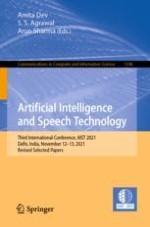2022 | OriginalPaper | Buchkapitel
Dictionary Vectorized Hashing of Emotional Recognition of Text in Mutual Conversation
verfasst von : M. Shyamala Devi, D. Manivannan, N. K. Manikandan, Ankita Budhia, Sagar Srivastava, Manshi Rohella
Erschienen in: Artificial Intelligence and Speech Technology
Aktivieren Sie unsere intelligente Suche, um passende Fachinhalte oder Patente zu finden.
Wählen Sie Textabschnitte aus um mit Künstlicher Intelligenz passenden Patente zu finden. powered by
Markieren Sie Textabschnitte, um KI-gestützt weitere passende Inhalte zu finden. powered by
